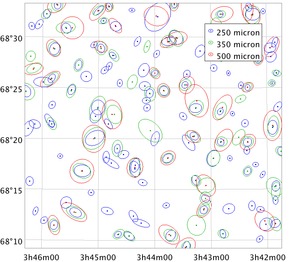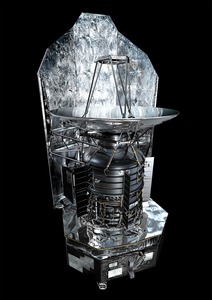Availability of the Herschel SPIRE Point Source Catalog; Final pipeline products and software from the HSC
In this issue
- Availability of the Herschel SPIRE Point Source Catalog
- Final pipeline products and software available from the HSC
1. Availability of the Herschel SPIRE Point Source Catalog
 We are pleased to announce the availability of the Herschel SPIRE Point Source Catalog (SPSC), containing more than 1.6 million entries among the three SPIRE bands.
We are pleased to announce the availability of the Herschel SPIRE Point Source Catalog (SPSC), containing more than 1.6 million entries among the three SPIRE bands.
SPIRE mapped about 9% of the sky in submillimeter broad-band filters centered at wavelengths of 250, 350, and 500 microns (1199, 857, and 600 GHz, respectively), with spatial resolutions of 17.9", 24.2" and 35.4”, respectively. The SPSC was extracted from a total of 6878 Herschel observations, consisting of a serendipitous mix of program science observations with sky coverage to varying depths and calibration observations performed in standard configurations.
The photometry was obtained by a systematic and homogeneous source extraction procedure, followed by a rigorous quality check that emphasized reliability over completeness. Regions affected by strong Galactic emission, mostly in the Galactic Plane, were excluded, as they pushed the limits of the four source extraction methods that were used. Aimed primarily at point sources, the SPSC also contains a significant number of slightly extended sources. Due to the relatively large spatial extent of the SPIRE beams, a number of point or extended sources in the SPSC can actually be composites of multiple sources seen at shorter wavelengths. Users are encouraged to trace back catalog entries to the originally contributing detections in SPIRE observations via the cross-identification table available for download.
The SPSC is available from the Infrared Science Archive (IRSA) using the Catalog Search Tool for Herschel catalog data, as well as from the Herschel Science Centre (HSC) web site at https://www.cosmos.esa.int/web/herschel/spire-point-source-catalogue.
For further details on the SPSC construction, detailed content, guidelines, and validation, the SPSC’s Explanatory Supplement should be consulted. Users should pay particular attention to the Cautionary Notes in the Supplement before using the contents of the SPSC for their research.
Image caption: Positions and shape parameters of SPSC sources in an exemplary arbitrary and largely "empty" area of the sky. The three SPIRE bands are at 250 (blue), 350 (green), and 500 (red) microns, respectively. Good positional correspondence of brighter point sources, as well as source multiplicity due to confusion at low flux levels, can be seen.
2. Final pipeline products and software available from the HSC
 The final bulk reprocessing in an automated fashion by the Herschel Standard Product Generation (SPG) pipelines of the entire contents of the Herschel Science Archive (HSA), using a set of different versions of HIPE (14.1, 14.2.1, or 14.2.2, depending on the instrument and observing mode), has been completed by the HSC and is available via HSA 8.0. No further pipeline reprocessing is envisaged. In addition, the 'legacy version' of the Herschel Interactive Data Processing Environment (HIPE), 15.0, is now available for download at http://www.cosmos.esa.int/web/herschel/hipe-download. No further development related to HIPE is planned for the remainder of Herschel Post-Operations. For information about 'What's New in HIPE 15.0', visit http://herschel.esac.esa.int/twiki/bin/view/Public/HipeWhatsNew15x#Highlights.
The final bulk reprocessing in an automated fashion by the Herschel Standard Product Generation (SPG) pipelines of the entire contents of the Herschel Science Archive (HSA), using a set of different versions of HIPE (14.1, 14.2.1, or 14.2.2, depending on the instrument and observing mode), has been completed by the HSC and is available via HSA 8.0. No further pipeline reprocessing is envisaged. In addition, the 'legacy version' of the Herschel Interactive Data Processing Environment (HIPE), 15.0, is now available for download at http://www.cosmos.esa.int/web/herschel/hipe-download. No further development related to HIPE is planned for the remainder of Herschel Post-Operations. For information about 'What's New in HIPE 15.0', visit http://herschel.esac.esa.int/twiki/bin/view/Public/HipeWhatsNew15x#Highlights.IRSA will be providing access to the final pipeline products soon. We will notify users in an upcoming Newsletter when this access is available.
Contact Us
Your feedback is welcome on any issue, please send your thoughts to:
nhsc@ipac.caltech.edu





